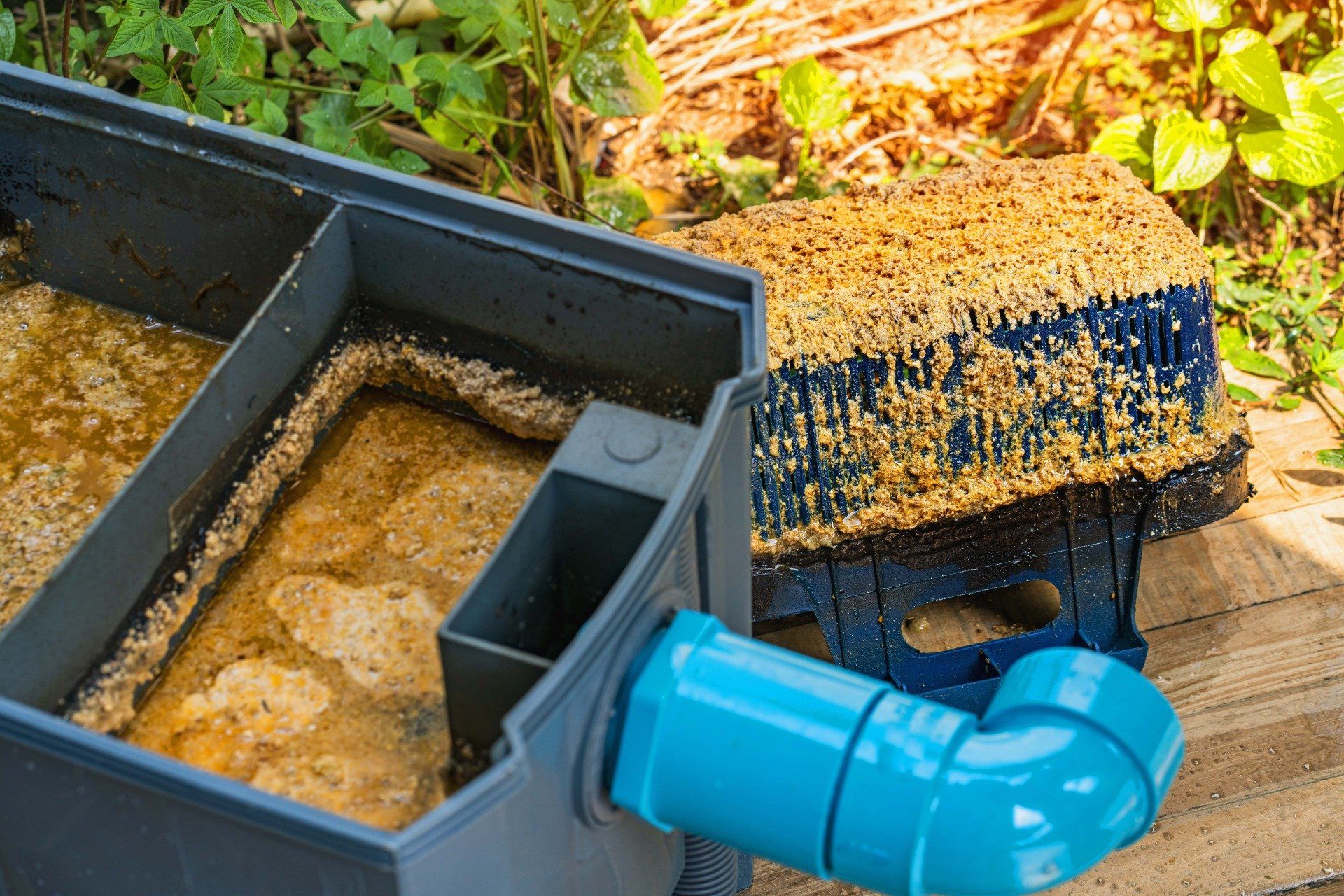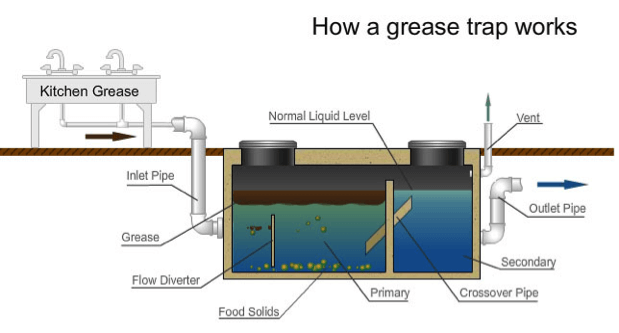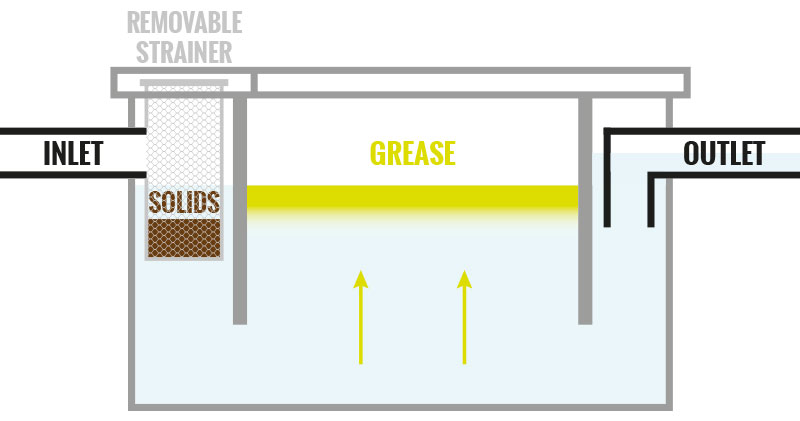Disclosure: This post contains affiliate links and I will be compensated if you make a purchase after clicking through my links. Learn More
Have you ever wondered what happens to all that grease and oil that washes down your kitchen sink? It doesn’t just disappear into thin air.
This is where a grease trap comes in. Understanding what a grease trap is could be the difference between a smoothly running kitchen and a plumbing disaster. By the end of this article, you’ll not only know what a grease trap does but also why it’s crucial for your home or business.
Keep reading to learn how this simple device can save you money, time, and a whole lot of hassle.
Grease Trap Basics
Grease traps are essential in commercial kitchens. They prevent fats, oils, and grease from entering the plumbing system. Understanding grease trap basics is crucial for efficient kitchen operations. Proper maintenance can save money and protect the environment. Let’s explore the definition and function of grease traps, and the types available.
Definition And Function
A grease trap is a plumbing device. It intercepts greasy substances from wastewater. This device reduces blockages in sewer pipes. Grease traps collect and separate grease from water. They use gravity to trap grease at the top. Cleaner water flows out to the sewer system. Regular cleaning ensures optimal performance.
Types Of Grease Traps
There are different types of grease traps. Passive traps are simple and require manual cleaning. They are suitable for small establishments. Automatic traps have mechanical parts. They self-clean and store grease separately. These traps are ideal for larger kitchens. Each type has its advantages. Choosing the right one depends on your kitchen’s needs.
Importance For Businesses
Grease traps play a crucial role in preventing plumbing issues for businesses. They effectively separate fats, oils, and grease from wastewater, ensuring smoother operations. This simple device helps maintain a clean environment, reducing costly repairs and potential fines.
In the bustling world of business, small details can have a significant impact on success. One such detail is the grease trap. Often overlooked, grease traps play a crucial role in various industries, especially for restaurants and food establishments. Understanding the importance of grease traps can help you maintain a smoother operation and avoid potential pitfalls.
Environmental Impact
Grease traps are not just about managing waste; they are vital for protecting the environment. By capturing fats, oils, and grease (FOG) before they enter the sewage system, grease traps prevent blockages and reduce pollution. This action directly contributes to cleaner waterways and a healthier ecosystem.
Consider the damage an unchecked grease overflow can cause. Clogged pipes can lead to sewer overflows, harming local wildlife and contaminating water supplies. By installing an effective grease trap, your business actively participates in environmental conservation.
Legal Requirements
Ignoring grease trap regulations can result in hefty fines and legal issues. Many local governments mandate the installation of grease traps in food service establishments. Compliance with these laws ensures that your business operates within legal boundaries.
Imagine the disruption a legal battle could cause. It could tarnish your reputation and drain financial resources. Staying informed about local regulations and adhering to them protects your business from unnecessary legal headaches.
Health And Safety Benefits
Grease traps also play a pivotal role in maintaining health and safety standards. They prevent the buildup of harmful bacteria and reduce fire hazards associated with grease accumulation. This makes your establishment safer for both employees and customers. Picture a kitchen floor slippery with grease. This isn’t just a cleaning issue; it’s a significant safety risk.
By managing grease effectively, you create a safer working environment, which can lead to better employee morale and customer satisfaction. Incorporating grease traps into your business operations is more than a regulatory checkbox. It’s a commitment to environmental stewardship, legal responsibility, and safety. Are you ready to make that commitment?
How Grease Traps Work
Grease traps play a vital role in commercial kitchens. They prevent fats, oils, and grease from entering wastewater systems. Understanding how grease traps work helps maintain efficient kitchen operations. Let’s dive into the process and components involved.
Separation Process
Grease traps rely on a simple mechanism. Wastewater flows into the trap. Heavy solids settle at the bottom. Grease and oils float on top. The trap captures these elements, allowing clean water to exit. This separation minimizes blockages and environmental harm.
Grease traps slow down water flow. This allows time for separation. The slower the flow, the better the separation. It’s an effective way to protect plumbing systems.
Components Explained
Grease traps consist of several key parts. The inlet pipe carries wastewater in. The outlet pipe lets treated water exit. Inside, a baffle controls water flow. This aids in separation.
The main chamber holds waste. It stores solids and grease. Regular cleaning is essential. It ensures the trap works efficiently. Some traps have a secondary chamber. This offers additional separation.
Understanding these components helps in maintenance. Proper care prolongs the lifespan of grease traps. It keeps kitchen operations smooth and hassle-free.

Credit: www.southerngreen.com
Installation Considerations
Installing a grease trap is crucial for commercial kitchens. Proper installation ensures efficient operation and compliance with regulations. Considerations include size selection and hiring professionals.
Choosing The Right Size
Size affects performance and capacity. Calculate kitchen output to determine the trap size. Larger kitchens need bigger traps for effective grease management. Consult with suppliers for guidance on sizing.
Small traps often overflow. This can lead to plumbing issues. Oversized traps waste resources. Accurate size selection balances efficiency and cost.
Professional Installation
Professional installation ensures correct setup. Experts understand local regulations. They handle permits and inspections. This saves time and prevents fines.
Professionals also offer maintenance advice. They ensure the trap functions efficiently. This enhances longevity and reduces repair costs.
DIY installation risks errors. These can lead to system failures. Hiring professionals offers peace of mind and reliability.
Maintenance And Cleaning
Grease traps play a vital role in plumbing by capturing fats, oils, and greases from wastewater. Regular maintenance ensures efficient functioning, preventing blockages and foul odors. Cleaning involves removing accumulated grease and debris, helping maintain a hygienic environment and prolonging the lifespan of plumbing systems.
Maintaining and cleaning a grease trap is crucial for its effective operation. A well-maintained grease trap prevents blockages and foul odors, ensuring your kitchen runs smoothly. But how often should it be cleaned, and what signs indicate a malfunction? Let’s dive into these important aspects.
Regular Cleaning Schedule
Setting up a regular cleaning schedule for your grease trap is essential. A consistent routine helps prevent buildup that can lead to clogs and expensive repairs. Typically, commercial kitchens should clean their grease traps every one to three months.
However, the frequency can vary based on the volume of grease produced. A small café might manage with quarterly cleanings, while a bustling restaurant might need monthly attention.
Missing a cleaning can result in an unpleasant surprise—a clogged trap on a busy Friday night. Regular checks and cleanings save you from such mishaps.
Signs Of Malfunction
What if your grease trap isn’t working properly? Recognizing signs of malfunction can prevent bigger issues down the line. Foul smells in the kitchen or slow drainage are red flags. These symptoms often point to a trap that’s overdue for cleaning or needs repair. Grease backing up into sinks or drains is another warning sign.
If you notice these, it’s time for immediate action. Ignoring these signals can lead to costly plumbing issues. Have you ever faced an unexpected grease trap problem? Share your experiences in the comments. Your insights could help others navigate similar challenges. Regular maintenance and being vigilant about these signs can save you time and money. Plus, it keeps your kitchen running without a hitch.
Cost Factors
Understanding the cost factors of grease traps is important for businesses. Costs vary based on several elements. These include installation and maintenance. Each factor can impact your budget. Knowing these details helps in planning effectively.
Installation Costs
Installation costs depend on trap size and type. Larger traps require more material and labor. Location also affects cost. Easy access can reduce labor fees. Complex installations may need special equipment. This increases overall expenses. Professional services ensure correct setup. They may charge a premium for expertise.
Maintenance Expenses
Routine cleaning keeps grease traps functional. Professional cleaning prevents blockages. Regular service fees vary by provider. Some offer package deals for savings. Frequency of cleaning impacts costs. High usage demands more frequent service. Replacement parts add to expenses. Worn parts need timely replacement to avoid bigger issues. Proper maintenance reduces long-term costs.
Choosing A Provider
Grease traps prevent fats, oils, and grease from entering wastewater systems. Choosing a reliable provider ensures proper installation and maintenance. This safeguards plumbing and the environment efficiently.
Choosing a provider for your grease trap maintenance is a decision that can greatly impact your business. You want someone reliable, efficient, and knowledgeable. Selecting the right provider ensures your system runs smoothly, preventing costly breakdowns and regulatory headaches. But how do you find the right provider? Let’s dive into the key qualities you should look for and the questions you should ask.
Key Qualities To Look For
When searching for a grease trap service provider, prioritize experience. A company with a proven track record knows the ins and outs of grease trap systems. They understand the common issues and have solutions ready. Reliability is crucial. You need a provider who shows up on time and performs the service thoroughly.
If they are consistently late or skip appointments, your grease trap could face problems. Consider their knowledge of local regulations. Are they familiar with the standards your business must adhere to? A knowledgeable provider will help keep your business compliant, avoiding fines and penalties.
Questions To Ask
What services do you offer? Ensure they provide everything from installation to regular maintenance and emergency support. How do you handle waste disposal? Proper disposal is crucial to avoid environmental issues and fines. Ask about their disposal process.
Do you offer service contracts? These can provide regular maintenance at a predictable cost, ensuring your grease trap runs smoothly. Can you provide references? Talking to other businesses who have used their services can give you insights into their reliability and quality. You might wonder if you should focus more on cost than quality.
Remember, a cheap provider might cost more in the long run due to poor service leading to system failures. Ultimately, choosing the right grease trap provider is about finding a balance between experience, reliability, and regulatory knowledge. Don’t rush the decision, and be sure to ask the right questions to find a provider that fits your needs perfectly.

Credit: grease-cycle.com
Grease Trap Innovations
Grease Trap Innovations have transformed the way restaurants and households manage waste. It’s fascinating to see how technology and sustainability have made these devices more efficient and eco-friendly. Whether you’re running a bustling kitchen or just curious about waste management, understanding these innovations can offer practical benefits for you.
Technological Advancements
The evolution of grease traps is nothing short of remarkable. New technologies now allow grease traps to automatically monitor and clean themselves. This means fewer manual interventions and reduced labor costs for you.
Imagine a grease trap that alerts you when it needs maintenance or cleaning. Smart grease traps equipped with sensors can do just that. They send notifications to your smartphone, ensuring optimal performance and preventing clogs.
These advancements not only save time but also minimize the risk of overflow, keeping your kitchen safe and sanitary. Aren’t these innovations a game-changer for your kitchen operations?
Sustainable Solutions
In today’s eco-conscious world, sustainable grease traps are gaining popularity. These devices are designed to recycle waste, turning it into usable products like biofuel. You can now contribute to environmental conservation while managing waste.
Some modern grease traps use biodegradable materials, reducing their environmental impact. This means less plastic waste, aligning your kitchen with greener practices.
Thinking about the future, how can your kitchen operations become more sustainable? By choosing innovative grease traps, you can take a step towards eco-friendly practices, benefiting both your business and the planet.

Credit: www.aquacure.co.uk
Frequently Asked Questions
What Does A Grease Trap Do?
A grease trap captures fats, oils, and grease from wastewater. It prevents them from entering the plumbing system.
How Often Should You Clean A Grease Trap?
Clean a grease trap every one to three months. Frequency depends on usage and local regulations.
Why Is A Grease Trap Necessary In Restaurants?
Grease traps prevent clogs and sewer blockages. They ensure smooth wastewater flow, keeping operations efficient.
How Does A Grease Trap Benefit The Environment?
Grease traps reduce pollution by trapping oils. This keeps harmful substances out of waterways.
Final Words
Understanding grease traps is essential for any kitchen. These devices help prevent plumbing issues. They catch fats, oils, and grease. This keeps pipes clear. Regular maintenance is crucial. It ensures the trap works effectively. Clean traps protect the environment. They keep harmful substances out of water systems.
Many restaurants rely on them. Grease traps save money on repairs. They also comply with local regulations. Choosing the right trap matters. Consider size and usage. Proper installation is key. With a grease trap, kitchens stay safe and efficient. This small device makes a big impact.


